Railway Heritage Footprints in the West Donlands – Part 1 of 6
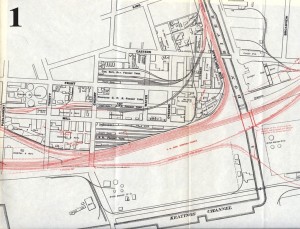 Click on each image for a closer look!
Click on each image for a closer look!
On Thursday, January 12, 2012, a press conference was held by Waterfront Toronto to unveil plans for the $514 million Athlete’s Village at the 2015 Pan American Games. The Village will be located on 35 acres of property centred on Front Street, between Bayview Avenue in the east and Cherry Street in the west and from north of Front Street to the rail corridor. Unmentioned at the media event is the fact that most of this property, now referred to as the West Donlands and being redeveloped by Waterfront Toronto, was originally devoted to railway facilities as well as various industries served by rail. This article will review the history of the area, whose railway provenance dates back to the 1850′s.
For easy reference, IMAGE #1 is a railway map of the area that dates from 1924. The red lines indicate new elevated track that would soon be built for the Toronto Grade Separation, now known as the Union Station Rail Corridor. Photographs of this area are relatively scarce since it has always been a grimy industrial part of town not depicted in the numerous view books that comprise a visual record of the city’s development.
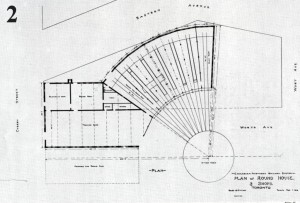 N
N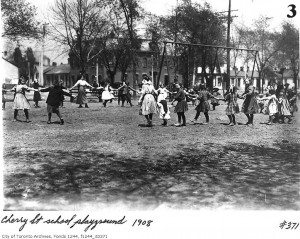 ortheast of Front and Cherry streets was a freight yard on a lot originally acquired by the Canadian Northern Ontario Railway in 1905. Included was a small park known as St. Lawrence Square. In 1908, CNoR made plans to build a seven-stall roundhouse with attached machine shop and 70-foot turntable which are seen in IMAGE #2. The roundhouse was never built and for a few years, CNoR made the property available to the city for a municipal playground seen in IMAGE #3. In 1912, the railway built a large wooden freight shed with a cast iron roof at this location and the park disappeared.
ortheast of Front and Cherry streets was a freight yard on a lot originally acquired by the Canadian Northern Ontario Railway in 1905. Included was a small park known as St. Lawrence Square. In 1908, CNoR made plans to build a seven-stall roundhouse with attached machine shop and 70-foot turntable which are seen in IMAGE #2. The roundhouse was never built and for a few years, CNoR made the property available to the city for a municipal playground seen in IMAGE #3. In 1912, the railway built a large wooden freight shed with a cast iron roof at this location and the park disappeared.
In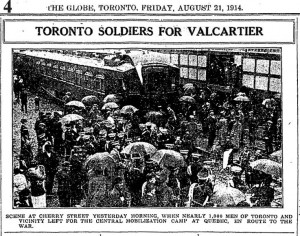 the first months of World War I, railway debarkation points for troop trains were chaotic as thousands of relatives and well-wishers would converge to say goodbye to their loved ones who were traveling to training camps before being shipped overseas. The old Union Station was so severely overcrowded at the best of times, that the railways and the military authorities came up with alternative debarkation points, including the Canadian Pacific Railway Don Station and the CNoR Cherry St. freight shed. Just two weeks after war was declared, one of the first contingents of 1,000 men shipped out on August 20, 1914 from Cherry St. to the Valcartier training camp near Quebec City and then overseas. (IMAGE #4)
the first months of World War I, railway debarkation points for troop trains were chaotic as thousands of relatives and well-wishers would converge to say goodbye to their loved ones who were traveling to training camps before being shipped overseas. The old Union Station was so severely overcrowded at the best of times, that the railways and the military authorities came up with alternative debarkation points, including the Canadian Pacific Railway Don Station and the CNoR Cherry St. freight shed. Just two weeks after war was declared, one of the first contingents of 1,000 men shipped out on August 20, 1914 from Cherry St. to the Valcartier training camp near Quebec City and then overseas. (IMAGE #4)
A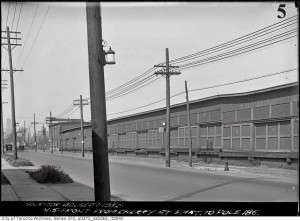 fter this property was acquired by Canadian National at the end of the war, a new brick freight office was built at the northeast corner of Front and Cherry streets. IMAGE #5 shows the freight shed looking west along Front Street toward Cherry Street, with the brick office building at the west end. According to the City of Toronto’s Inventory of Heritage Properties, to which the building was added in 2005, this structure was built in 1923, the freight yard tracks were taken up around 1970 and the building was then used by CN Police. However, the same document also incorrectly claims that the property was previously owned by the Grand Trunk Railway, which became part of Canadian National in 1923. In fact, the GTR freight yard was two blocks to the south.
fter this property was acquired by Canadian National at the end of the war, a new brick freight office was built at the northeast corner of Front and Cherry streets. IMAGE #5 shows the freight shed looking west along Front Street toward Cherry Street, with the brick office building at the west end. According to the City of Toronto’s Inventory of Heritage Properties, to which the building was added in 2005, this structure was built in 1923, the freight yard tracks were taken up around 1970 and the building was then used by CN Police. However, the same document also incorrectly claims that the property was previously owned by the Grand Trunk Railway, which became part of Canadian National in 1923. In fact, the GTR freight yard was two blocks to the south.
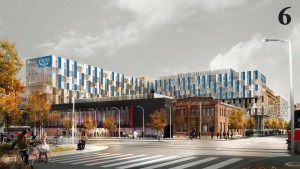
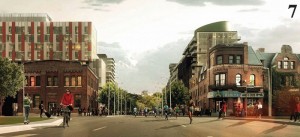 That quibble aside, the listing on the inventory means that the building will be preserved in the current redevelopment. IMAGES 6 & 7 are renderings from Waterfront Toronto that look east along Front Street and show the CNR freight office on the left. IMAGE #8 is a photograph I took of the back of the building in 2004. The false front was part of a Detroit police station set for a Hollywood movie being filmed there at the time, Assault on Precinct 13. It should be noted that the photograph was taken in May so the snow on the ground is fake, a form of wintry form of astro-turf that the production left in place after the filming was completed.
That quibble aside, the listing on the inventory means that the building will be preserved in the current redevelopment. IMAGES 6 & 7 are renderings from Waterfront Toronto that look east along Front Street and show the CNR freight office on the left. IMAGE #8 is a photograph I took of the back of the building in 2004. The false front was part of a Detroit police station set for a Hollywood movie being filmed there at the time, Assault on Precinct 13. It should be noted that the photograph was taken in May so the snow on the ground is fake, a form of wintry form of astro-turf that the production left in place after the filming was completed.
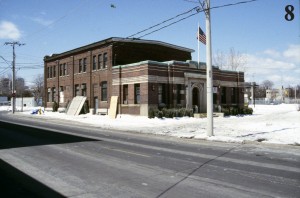
Click here to read part 2 of this article.
Article by Derek Boles, TRHA Historian

